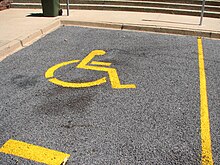Parking space: Difference between revisions
No edit summary |
|||
| Line 21: | Line 21: | ||
{{commonscat|Parking}} |
{{commonscat|Parking}} |
||
* [http://www.monkeymeter.com/drivetips/color_curb.php US Color Curbs Defined] |
* [http://www.monkeymeter.com/drivetips/color_curb.php US Color Curbs Defined] |
||
* [http://www.freeparkingspace.co.uk Find free parking space in UK] |
|||
[[Category:Parking]] |
[[Category:Parking]] |
||
[[Category:Road infrastructure]] |
[[Category:Road infrastructure]] |
||
Revision as of 14:47, 14 January 2010

A parking space is a location that is designated for parking. This can be in a parking garage or in a parking lot or on a city street. It is usually designated by a white-paint-on-tar rectangle indicated by three lines at the top, left and right of the designated area. The automobile fits inside the space, either by parallel parking, perpendicular parking or angled parking.
Space size

The typical small or compact space is about 25 square metres (270 sq ft), while the average space is about 30 square metres (320 sq ft).[1] Note that this area includes the area for parking space plus the circulation areas, end of aisle areas/landscaping. Common angled or perpendicular parking spaces are 2.4 to 2.75 metres (7.9–9.0 ft) wide by 4.9 to 5.5 metres (16–18 ft) long. Some spaces can be as narrow as 2.3 metres (7.5 ft) and as wide as 3.2 metres (10 ft). The choice of specific parking dimensions depends upon the function of the parking - the greater the use of the space (high turnover) and/or more retail customer in nature - the larger dimensions are commonly utilized. Many parking spaces contain a barrier which is used to prevent cars from pulling too far into the space.
A typical parking space adjacent to the curb (parallel) is 2.4 metres (7.9 ft) wide by 6.1 metres (20 ft) long. Parallel spaces are commonly marked 2.1 to 2.4 metres (6.9–7.9 ft) wide. The length of parallel spaces are commonly marked 6.7 to 7.9 metres (22–26 ft) long to account for entry and exit maneuvering.
Disabled parking spaces

Some parking spaces are reserved as handicapped parking, for individuals with disabilities. Handicapped parking spaces are typically marked with the International Symbol of Access, though in practice, the design of the symbol varies widely.[2] In the United States the Access Board provides guidelines on parking spaces in the Accessible Rights-of-Way: A Design Guide, Revised Draft Guidelines for Accessible Public Right-of-Way and ADA Accessibility Guidelines for Buildings and Facilities (ADAAG).
US curb markings
Curb markings in the United States are prescribed by the Manual of Uniform Traffic Control Devices (MUTCD).[3] Local highway agencies may prescribe special colors for curb markings to supplement standard signs for parking regulation. California has designated an array of colors for curb regulations. A white curb designates passenger pick up or drop off. The green curb is for time limited parking. The yellow curb is for loading, and the blue curb is for disabled persons with proper vehicle identification. The red curb is for emergency vehicles only - fire lanes (no stopping, standing, or parking). In Oregon, yellow curb is utilized to indicate no parking. In Seattle, Washington, alternating red and yellow curb markings indicates a bus stop.
References
- ^ A Comprehensive Menu of Solutions to Parking Problems Victoria Transport Policy Institute
- ^ www.youcantparkhere.com A gallery of handicapped parking symbols.
- ^ Manual of Uniform Traffic Control Devices, FHWA, 2003, Section 3B-21.
